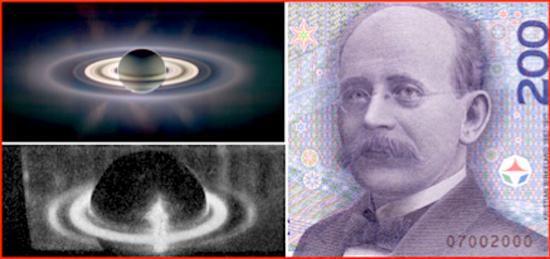
Right: Kristian Birkeland on the 200 Kroner note. Bottom left: Birkeland’s terrella simulating Saturn’s rings. Top left: Cassini image of Saturn’s rings.
Jun 14, 2017
Kristian Birkeland was called the first space scientist because of his pioneering experiments in the early 1900s. June 15th marks the 100th anniversary of his death.
“It seems to be a natural consequence of our points of view to assume that the whole of space is filled with electrons and flying electric ions of all kinds.” – Kristian Birkeland.
Kristian Birkeland is noted for his investigation into the cause and nature of the Earth’s aurora. In 1902, he embarked on an expedition to the Norwegian polar regions with scientific equipment to observe, measure and record the Northern Lights.
Based on his observations, Birkeland hypothesized that electric currents in the atmosphere whose source was the Sun itself powered the aurora. On returning to the University of Oslo, Birkeland set about testing his ideas. He built a vacuum chamber and placed a magnetized metal ball called a terrella inside it, representing the Earth. Birkeland electrically charged the terrella and the chamber at varying magnitudes and polarities and observed how the terrella behaved in its artificial atmosphere.
Birkeland wrote:
“The magnetic globe was then made the cathode in the vacuum-box, and experiments were carried on under these conditions for many years. It was in this way that there gradually appeared experimental analogies to various cosmic phenomena, such as zodiacal light, Saturn’s rings, sun-spots and spiral nebulae.”
In 1908 and 1913, Birkeland published two volumes of his work, which includes mathematical models and images that appeared both to support his theories and to model aspects of comet tails, the Sun and planetary rings. The scientific world largely rejected his findings.
To help fund his expeditions and research, Birkeland applied his physics to technology and industry. In 1901, he patented an electromagnetic gun and set up a company, Birkeland’s Firearms. After successfully constructing a 10-meter-long, 6.5-centimeter calibre cannon firing 10-kilogram iron projectiles that “always hit their target”, he planned a version that could fire a 500 kilogram projectile at 500 meters per second, but it proved too expensive.
In 1939, Hannes Alfvén promoted Birkeland’s ideas in his own theory of magnetic storms and of the aurorae. In the mid-1960s, satellites discovered magnetic disturbances in the aurora which some scientists argued supported Birkeland’s theories. In 1973, the navy satellite Triad detected the magnetic signatures of electric currents in the aurora, finally vindicating Birkeland’s theory of the aurora after 65 years.
Ian Tresman
Further reading: Kristian_Birkeland The Northern Lights: The True Story of the Man Who Unlocked the Secrets of the Aurora Borealis (2001) by Lucy Jago












